Optimization of Flow Channel Design with Porous Medium Layers in a Proton Exchange Membrane Electrolyzer Cell
Abstract
1. Introduction
2. Materials and Methods
2.1. CFD Model and Simulation
2.2. Validation and Grid Independence
2.3. Optimization with the Taguchi Method
2.4. Analysis of Variance
3. Results and Discussion
3.1. Flow Field Analysis and Pressure Distribution
3.2. Orthogonal Array and Taguchi Analysis
3.3. Analysis of Variance (ANOVA)
4. Conclusions
Author Contributions
Funding
Data Availability Statement
Conflicts of Interest
Nomenclature
| External force acting on the fluid (N) | |
| Variance ratio test | |
| Degree of freedom | |
| Unit vector | |
| Permeability of the porous media (m2) | |
| Number of tests | |
| Inlet pressure (Pa) | |
| Outlet pressure (Pa) | |
| Pressure drop (Pa) | |
| Pressure (Pa) | |
| Squares of deviation | |
| Signal-to-noise ratio; smaller is better | |
| Fluid velocity vector (ms−1) | |
| Greek letters | |
| Drag coefficient | |
| Porosity | |
| Fluid density (kgm−1) | |
| dynamic viscosity (Pas) | |
References
- Baykara, S.Z. Hydrogen: A brief overview on its sources, production and environmental impact. Int. J. Hydrogen Energy 2018, 43, 10605–10614. [Google Scholar] [CrossRef]
- Chen, W.-H.; Chen, C.-Y. Water gas shift reaction for hydrogen production and carbon dioxide capture: A review. Appl. Energy 2020, 258, 114078. [Google Scholar] [CrossRef]
- Bockris, J.O.M. The hydrogen economy: Its history. Int. J. Hydrogen Energy 2013, 38, 2579–2588. [Google Scholar] [CrossRef]
- Nikolaidis, P.; Poullikkas, A. A comparative overview of hydrogen production processes. Renew. Sustain. Energy Rev. 2017, 67, 597–611. [Google Scholar] [CrossRef]
- Colella, W.; O’Hayre, R.; Cha, S.-W.; Prinz, F.B. Fuel Cell Fundamentals; John Wiley: Hoboken, NJ, USA, 2009. [Google Scholar]
- Neef, H.-J. International overview of hydrogen and fuel cell research. Energy 2009, 34, 327–333. [Google Scholar] [CrossRef]
- Villagra, A.; Millet, P. An analysis of PEM water electrolysis cells operating at elevated current densities. Int. J. Hydrogen Energy 2019, 44, 9708–9717. [Google Scholar] [CrossRef]
- Lamy, C. From hydrogen production by water electrolysis to its utilization in a PEM fuel cell or in a SO fuel cell: Some considerations on the energy efficiencies. Int. J. Hydrogen Energy 2016, 41, 15415–15425. [Google Scholar] [CrossRef]
- Bessarabov, D.; Wang, H.; Li, H.; Zhao, N. Pem Electrolysis for Hydrogen Production: Principles and Applications; CRC Press: Boca Raton, FL, USA, 2016. [Google Scholar]
- Zhang, K.; Liang, X.; Wang, L.; Sun, K.; Wang, Y.; Xie, Z.; Wu, Q.; Bai, X.; Hamdy, M.S.; Chen, H.; et al. Status and perspectives of key materials for PEM electrolyzer. Nano Res. Energy 2022, 1, e9120032. [Google Scholar] [CrossRef]
- Falcão, D.S.; Pinto, A.M.F.R. A review on PEM electrolyzer modelling: Guidelines for beginners. J. Clean. Prod. 2020, 261, 121184. [Google Scholar] [CrossRef]
- Barbir, F. PEM electrolysis for production of hydrogen from renewable energy sources. Sol. Energy 2005, 78, 661–669. [Google Scholar] [CrossRef]
- Zaik, K.; Werle, S. Solar and wind energy in Poland as power sources for electrolysis process-A review of studies and experimental methodology. Int. J. Hydrogen Energy 2023, 48, 11628–11639. [Google Scholar] [CrossRef]
- Thomas, C. Fuel cell and battery electric vehicles compared. Int. J. Hydrogen Energy 2009, 34, 6005–6020. [Google Scholar] [CrossRef]
- Pivovar, B.; Rustagi, N.; Satyapal, S. Hydrogen at scale (H2@ Scale): Key to a clean, economic, and sustainable energy system. Electrochem. Soc. Interface 2018, 27, 47. [Google Scholar] [CrossRef]
- García-Valverde, R.; Espinosa, N.; Urbina, A. Simple PEM water electrolyser model and experimental validation. Int. J. Hydrogen Energy 2012, 37, 1927–1938. [Google Scholar] [CrossRef]
- Carvela, M.; Lobato, J.; Rodrigo, M.A. Chloralkali low temperature PEM reversible electrochemical cells. Electrochim. Acta 2021, 387, 138542. [Google Scholar] [CrossRef]
- Guo, Q.; Ye, F.; Guo, H.; Ma, C.F. Gas/Water and Heat Management of PEM-Based Fuel Cell and Electrolyzer Systems for Space Applications. Microgravity Sci. Technol. 2017, 29, 49–63. [Google Scholar] [CrossRef]
- Dang, J.; Yang, F.; Li, Y.; Zhao, Y.; Ouyang, M.; Hu, S. Experiments and microsimulation of high-pressure single-cell PEM electrolyzer. Appl. Energy 2022, 321, 119351. [Google Scholar] [CrossRef]
- Upadhyay, M.; Lee, S.; Jung, S.; Choi, Y.; Moon, S.; Lim, H. Systematic assessment of the anode flow field hydrodynamics in a new circular PEM water electrolyser. Int. J. Hydrogen Energy 2020, 45, 20765–20775. [Google Scholar] [CrossRef]
- Toghyani, S.; Afshari, E.; Baniasadi, E. Three-dimensional computational fluid dynamics modeling of proton exchange membrane electrolyzer with new flow field pattern. J. Therm. Anal. Calorim. 2019, 135, 1911–1919. [Google Scholar] [CrossRef]
- Nie, J.; Chen, Y.; Cohen, S.; Carter, B.D.; Boehm, R.F. Numerical and experimental study of three-dimensional fluid flow in the bipolar plate of a PEM electrolysis cell. Int. J. Therm. Sci. 2009, 48, 1914–1922. [Google Scholar] [CrossRef]
- Badduri, S.R.; Siripuram, R. Effect of Width of a Serpentine Flow Channel on PEM Fuel Cell Performance. In Proceedings of the Recent Advances in Renewable Energy Sources-RARES2021, Online, 26–27 February 2021. [Google Scholar]
- Kang, Z.; Yu, S.; Yang, G.; Li, Y.; Bender, G.; Pivovar, B.S.; Green, J.B.; Zhang, F.-Y. Performance improvement of proton exchange membrane electrolyzer cells by introducing in-plane transport enhancement layers. Electrochim. Acta 2019, 316, 43–51. [Google Scholar] [CrossRef]
- Ruiz, D.D.H.; Sasmito, A.P.; Shamim, T. Numerical investigation of the high temperature PEM electrolyzer: Effect of flow channel configurations. ECS Trans. 2013, 58, 99. [Google Scholar] [CrossRef]
- Nafchi, F.M.; Afshari, E.; Baniasadi, E.; Javani, N. A parametric study of polymer membrane electrolyser performance, energy and exergy analyses. Int. J. Hydrogen Energy 2019, 44, 18662–18670. [Google Scholar] [CrossRef]
- Tijani, A.S.; Barr, D.; Rahim, A.A. Computational modelling of the flow field of an electrolyzer system using CFD. Energy Procedia 2015, 79, 195–203. [Google Scholar] [CrossRef]
- Toghyani, S.; Fakhradini, S.; Afshari, E.; Baniasadi, E.; Abdollahzadeh Jamalabadi, M.Y.; Safdari Shadloo, M. Optimization of operating parameters of a polymer exchange membrane electrolyzer. Int. J. Hydrogen Energy 2019, 44, 6403–6414. [Google Scholar] [CrossRef]
- Saikia, S.; Verma, V.; Kakati, B.K.; Sivasakthivel, T.; Tarodiya, R. Optimization of solar integrated electrolyser system for hydrogen production using Taguchi method. Mater. Today Proc. 2022, 49, 397–402. [Google Scholar] [CrossRef]
- Chen, W.-H.; Tsai, Z.-L.; Chang, M.-H.; You, S.; Kuo, P.-C. Geometry optimization and pressure analysis of a proton exchange membrane fuel cell stack. Int. J. Hydrogen Energy 2021, 46, 16717–16733. [Google Scholar] [CrossRef]
- Marschall, R. 50 Years of Materials Research for Photocatalytic Water Splitting. Eur. J. Inorg. Chem. 2021, 2021, 2435–2441. [Google Scholar] [CrossRef]
- Hossain, M.S.; Shabani, B.; Cheung, C.P. Enhanced gas flow uniformity across parallel channel cathode flow field of Proton Exchange Membrane fuel cells. Int. J. Hydrogen Energy 2017, 42, 5272–5283. [Google Scholar] [CrossRef]
- Zick, A.; Homsy, G. Stokes flow through periodic arrays of spheres. J. Fluid Mech. 1982, 115, 13–26. [Google Scholar] [CrossRef]
- Lin, R.; Lu, Y.; Xu, J.; Huo, J.; Cai, X. Investigation on performance of proton exchange membrane electrolyzer with different flow field structures. Appl. Energy 2022, 326, 120011. [Google Scholar] [CrossRef]
- Vazifeshenas, Y.; Sedighi, K.; Shakeri, M. Heat transfer in PEM cooling flow field with high porosity metal foam insert. Appl. Therm. Eng. 2019, 147, 81–89. [Google Scholar] [CrossRef]
- Chen, W.-H.; Lin, Y.-Y.; Liu, H.-C.; Baroutian, S. Optimization of food waste hydrothermal liquefaction by a two-step process in association with a double analysis. Energy 2020, 199, 117438. [Google Scholar] [CrossRef]
- Chen, W.-H.; Wang, J.-S.; Chang, M.-H.; Mutuku, J.K.; Hoang, A.T. Efficiency improvement of a vertical-axis wind turbine using a deflector optimized by Taguchi approach with modified additive method. Energy Convers. Manag. 2021, 245, 114609. [Google Scholar] [CrossRef]
- Chen, W.H.; Tsai, Z.L.; Chang, M.H.; Hsu, T.H.; Kuo, P.C. Flow field simulation and pressure drop modeling by a porous medium in PEM fuel cells. Int. J. Energy Res. 2022, 46, 163–177. [Google Scholar] [CrossRef]
- Chen, W.H.; Li, Y.W.; Lin, C.C.; Chang, M.H.; Saravanakumar, A.; Saw, L.H. Multi—objective optimization design for pressure uniformity in a proton exchange membrane fuel cell stack. Int. J. Energy Res. 2022, 46, 18947–18963. [Google Scholar] [CrossRef]
- Ozdemir, S.N.; Taymaz, I.; Okumuş, E.; San, F.G.B.; Akgün, F. Experimental investigation on performance evaluation of PEM electrolysis cell by using a Taguchi method. Fuel 2023, 344, 128021. [Google Scholar] [CrossRef]
- Chauhan, R.; Singh, T.; Kumar, N.; Patnaik, A.; Thakur, N.S. Experimental investigation and optimization of impinging jet solar thermal collector by Taguchi method. Appl. Therm. Eng. 2017, 116, 100–109. [Google Scholar] [CrossRef]
- Wang, Y.; Chen, G.; Li, Y.; Yan, B.; Pan, D. Experimental study of the bio-oil production from sewage sludge by supercritical conversion process. Waste Manag. 2013, 33, 2408–2415. [Google Scholar] [CrossRef] [PubMed]
- Chen, W.-H.; Uribe, M.C.; Luo, D.; Jin, L.; Saw, L.H.; Lamba, R. Taguchi optimization and analysis of variance for thermoelectric generators with forced convection air cooling. Appl. Therm. Eng. 2023, 231, 120878. [Google Scholar] [CrossRef]

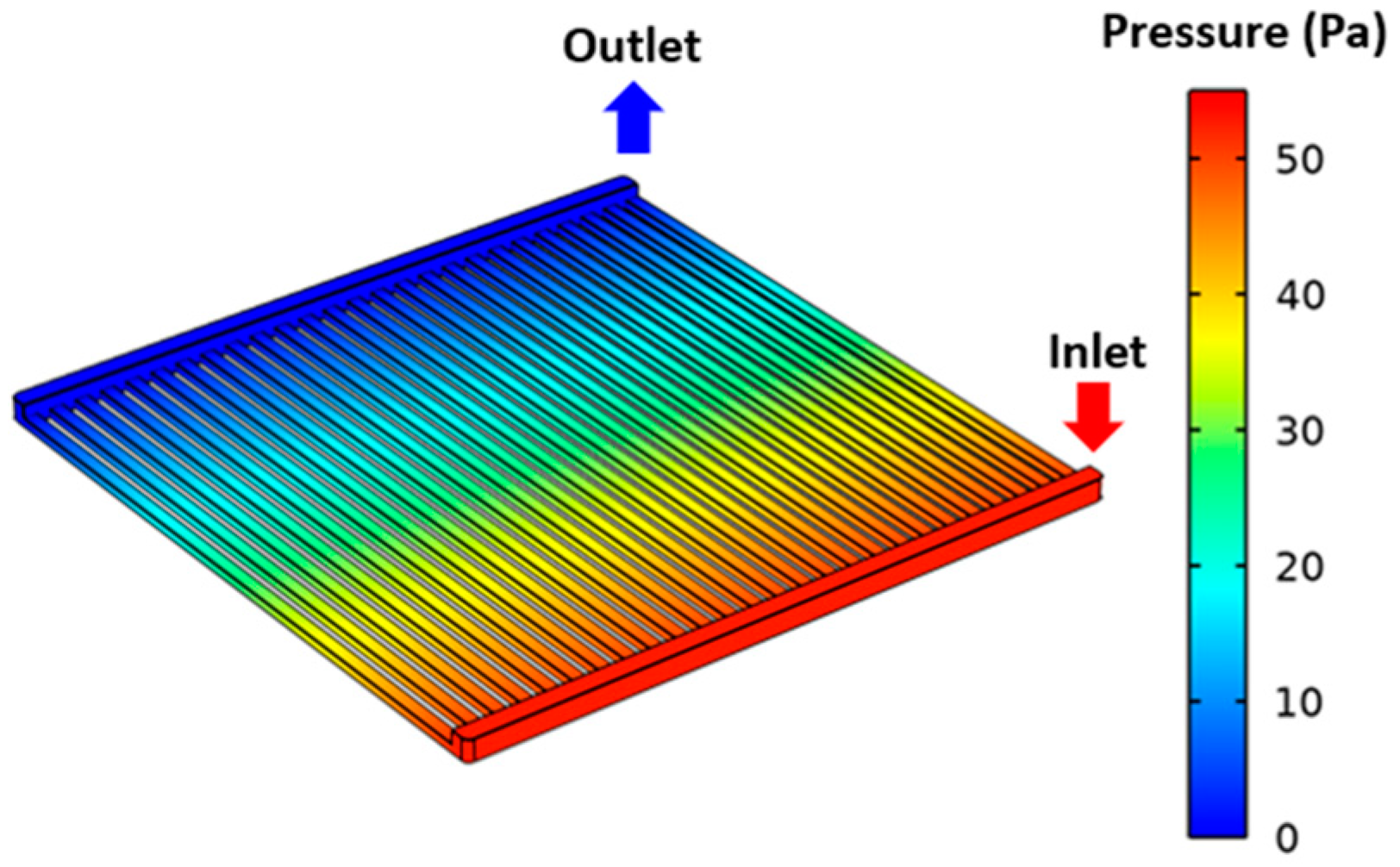
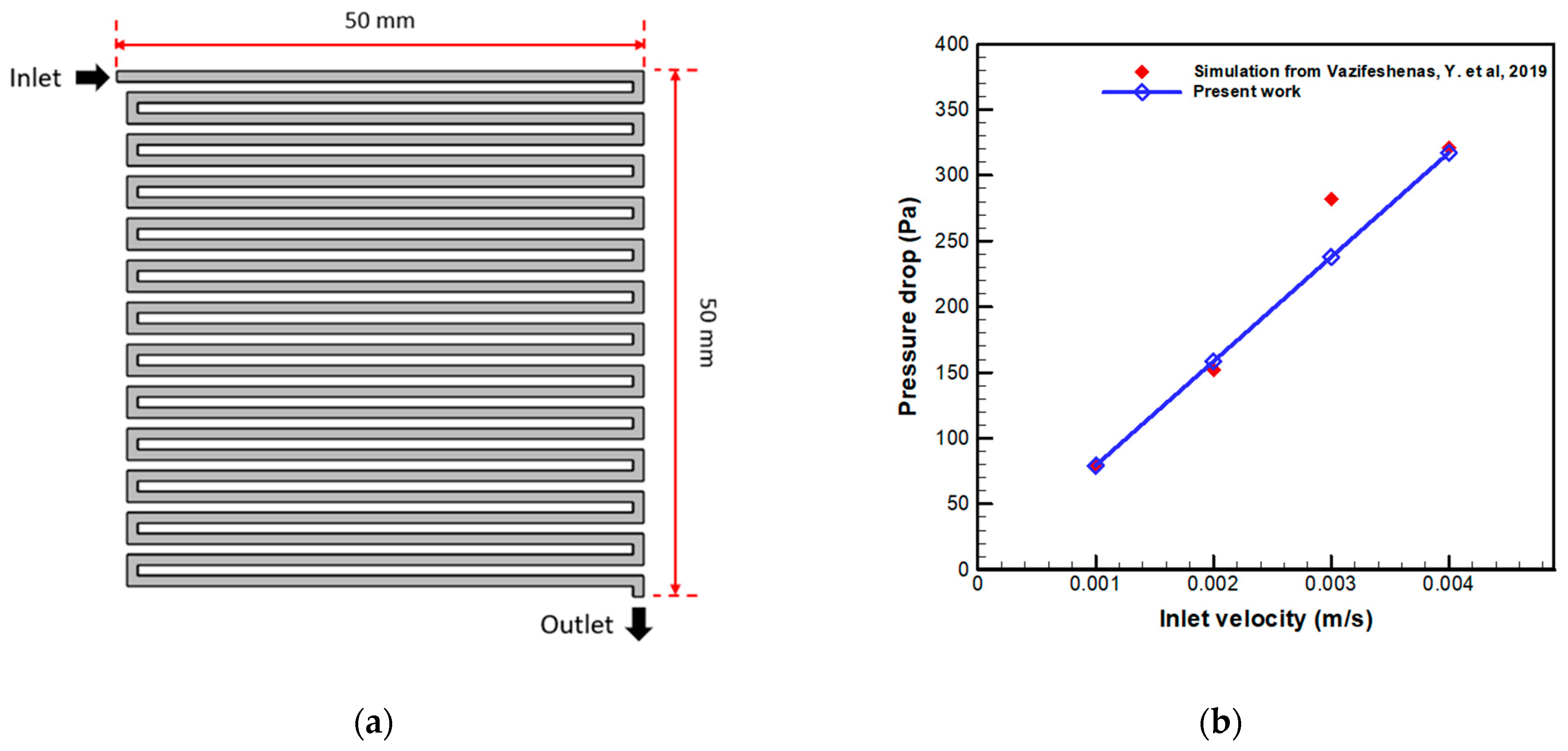
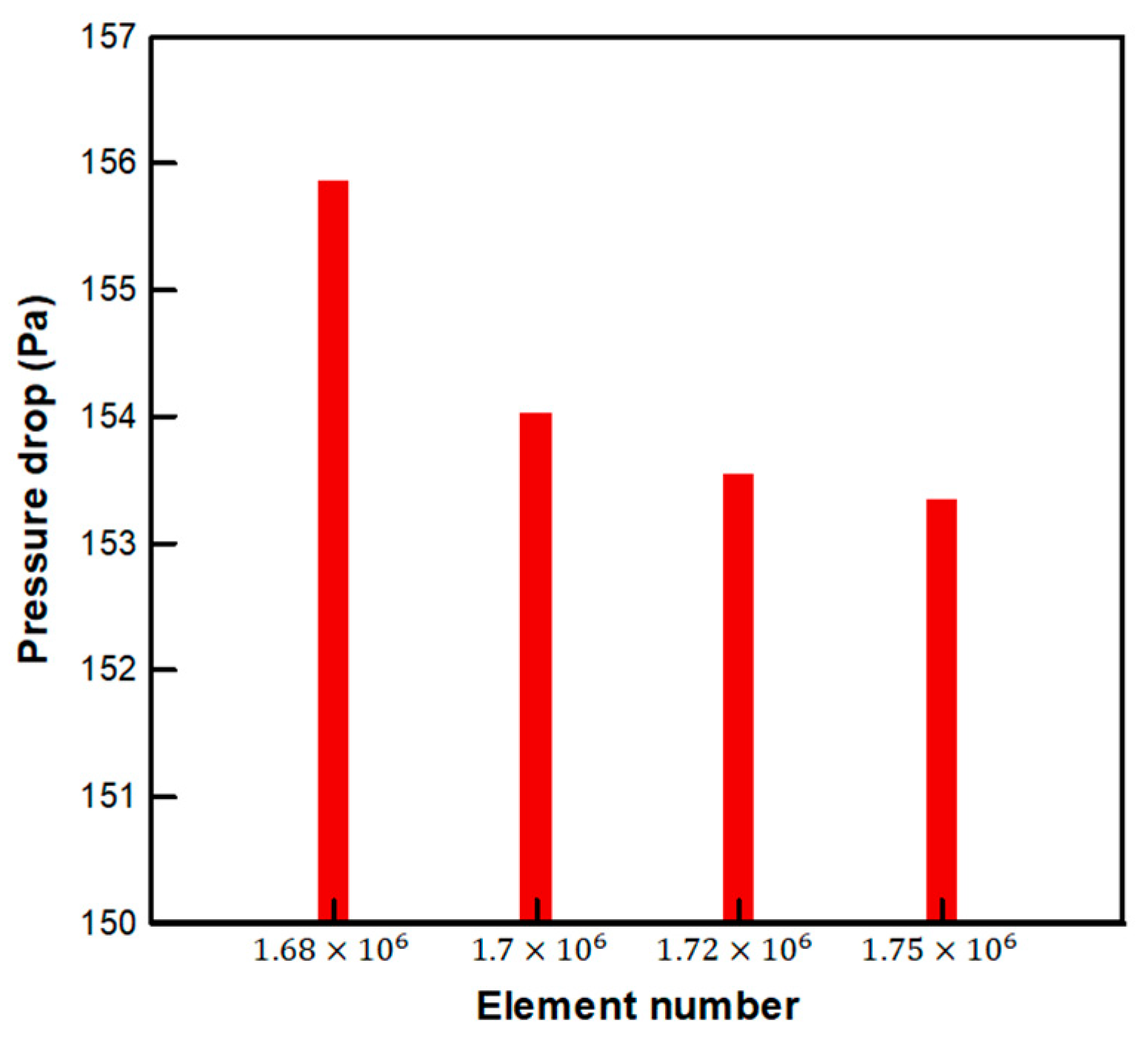


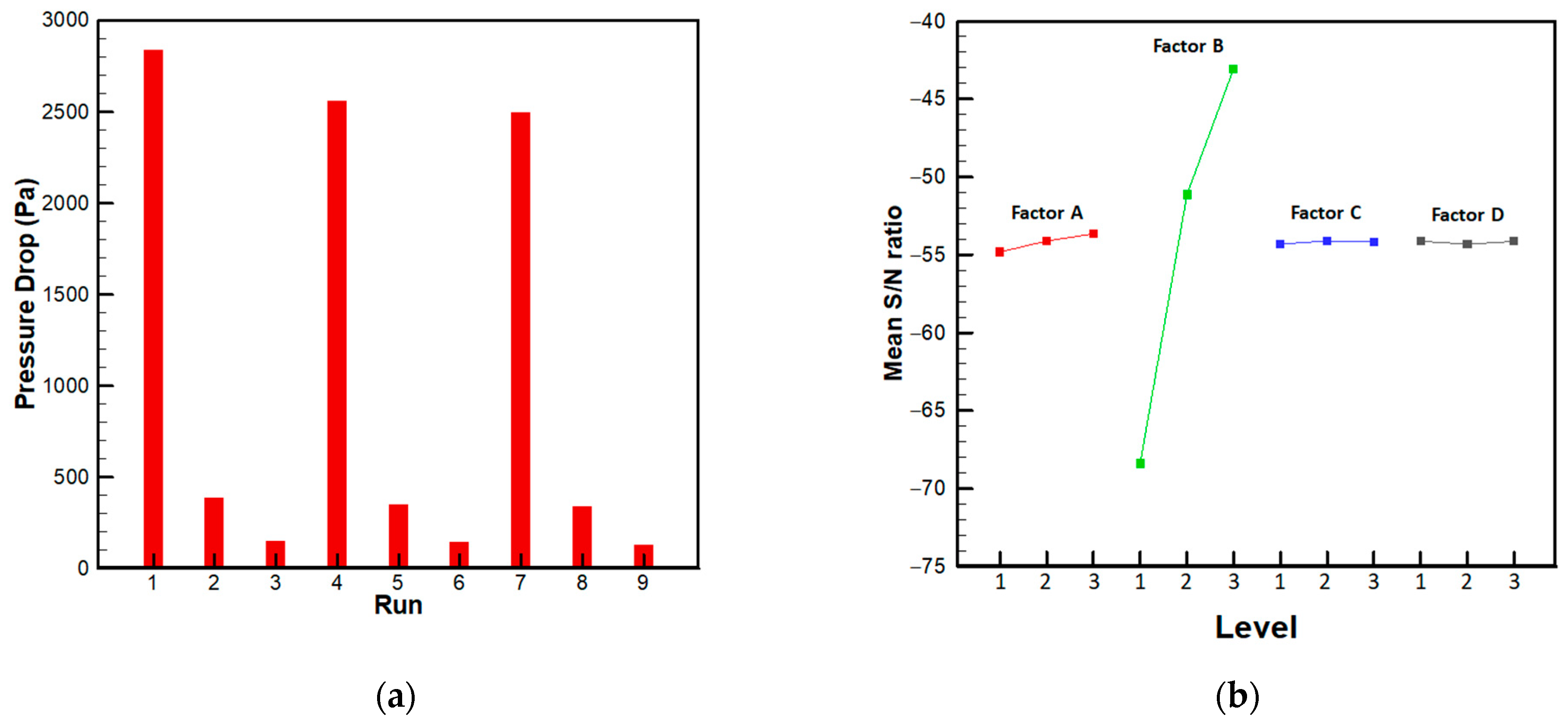

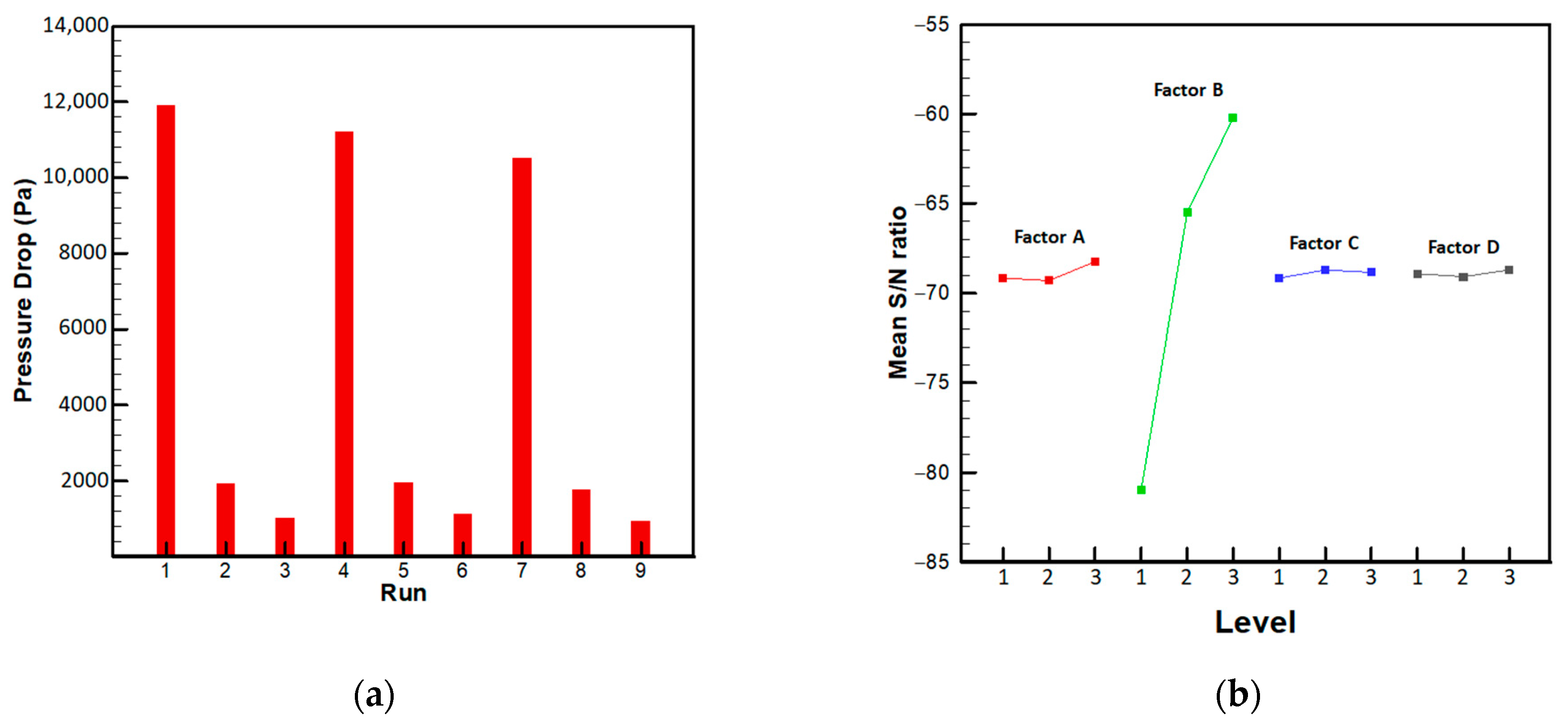

| Symbol | Factor | Unit | Level | ||
|---|---|---|---|---|---|
| 1 | 2 | 3 | |||
| A | Flow channel width | mm | 1 | 2 | 3 |
| B | Flow channel depth | mm | 0.1 | 0.5 | 1 |
| C | Particle diameter of large-pore porous layer | μm | 180 | 212 | 250 |
| D | Particle diameter of small-pore porous layer | μm | 2 | 5 | 7 |
| Simulation | Level | |||
|---|---|---|---|---|
| A | B | C | D | |
| R1 | 1 | 1 | 1 | 1 |
| R2 | 1 | 2 | 2 | 2 |
| R3 | 1 | 3 | 3 | 3 |
| R4 | 2 | 1 | 2 | 3 |
| R5 | 2 | 2 | 3 | 1 |
| R6 | 2 | 3 | 1 | 2 |
| R7 | 3 | 1 | 3 | 2 |
| R8 | 3 | 2 | 1 | 3 |
| R9 | 3 | 3 | 2 | 1 |
| Source | DF | Sum of Square | Mean Square | F-Value | p-Value | Percentage (%) |
|---|---|---|---|---|---|---|
| A | 2 | 193.72 | 96.86 | 2.05 | 0.33 | 0.30 |
| B | 2 | 64,391.30 | 32,195.65 | 682.50 | 0.01 | 99.40 |
| C | 2 | 101.89 | 50.94 | 1.08 | 0.48 | 0.16 |
| D | 2 | 94.35 | 47.17 | - | - | 0.15 |
| Factor | DF | Sum of Square | Mean Square | F-Value | p-Value | Percentage (%) |
|---|---|---|---|---|---|---|
| A | 2 | 30,817.31 | 15,408.65 | 1.75 | 0.36 | 0.27 |
| B | 2 | 1.14 × 107 | 5.7 × 106 | 646.40 | 0.00 | 99.41 |
| C | 2 | 18,780.35 | 9390.18 | 1.06 | 0.48 | 0.16 |
| D | 2 | 17,636.59 | 8818.29 | - | - | 0.15 |
| Factor | DF | Sum of Square | Mean Square | F-Value | p-Value | Percentage (%) |
|---|---|---|---|---|---|---|
| A | 2 | 4.77 × 105 | 2.39 × 105 | 1.86 | 0.349 | 0.25 |
| B | 2 | 1.92 × 108 | 9.58 × 107 | 748.32 | 1.33 × 10−3 | 99.47 |
| C | 2 | 2.79 × 105 | 1.40 × 105 | 1.09 | 0.478 | 0.14 |
| D | 2 | 2.56 × 105 | 1.28 × 105 | - | - | 0.13 |
Disclaimer/Publisher’s Note: The statements, opinions and data contained in all publications are solely those of the individual author(s) and contributor(s) and not of MDPI and/or the editor(s). MDPI and/or the editor(s) disclaim responsibility for any injury to people or property resulting from any ideas, methods, instructions or products referred to in the content. |
© 2023 by the authors. Licensee MDPI, Basel, Switzerland. This article is an open access article distributed under the terms and conditions of the Creative Commons Attribution (CC BY) license (https://creativecommons.org/licenses/by/4.0/).
Share and Cite
Chen, W.-H.; Wang, Y.-S.; Chang, M.-H.; Jin, L.; Saw, L.H.; Lin, C.-C.; Huang, C.-Y. Optimization of Flow Channel Design with Porous Medium Layers in a Proton Exchange Membrane Electrolyzer Cell. Energies 2023, 16, 5642. https://doi.org/10.3390/en16155642
Chen W-H, Wang Y-S, Chang M-H, Jin L, Saw LH, Lin C-C, Huang C-Y. Optimization of Flow Channel Design with Porous Medium Layers in a Proton Exchange Membrane Electrolyzer Cell. Energies. 2023; 16(15):5642. https://doi.org/10.3390/en16155642
Chicago/Turabian StyleChen, Wei-Hsin, Yaun-Sheng Wang, Min-Hsing Chang, Liwen Jin, Lip Huat Saw, Chih-Chia Lin, and Ching-Ying Huang. 2023. "Optimization of Flow Channel Design with Porous Medium Layers in a Proton Exchange Membrane Electrolyzer Cell" Energies 16, no. 15: 5642. https://doi.org/10.3390/en16155642
APA StyleChen, W.-H., Wang, Y.-S., Chang, M.-H., Jin, L., Saw, L. H., Lin, C.-C., & Huang, C.-Y. (2023). Optimization of Flow Channel Design with Porous Medium Layers in a Proton Exchange Membrane Electrolyzer Cell. Energies, 16(15), 5642. https://doi.org/10.3390/en16155642









